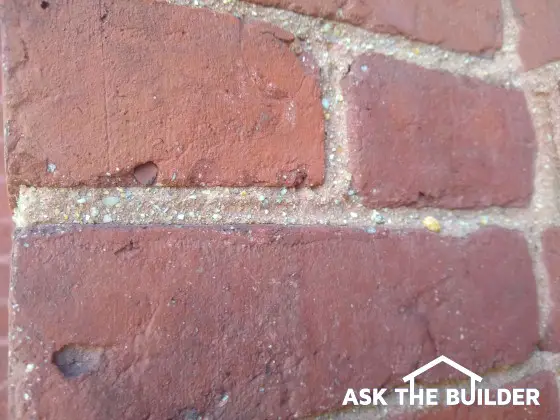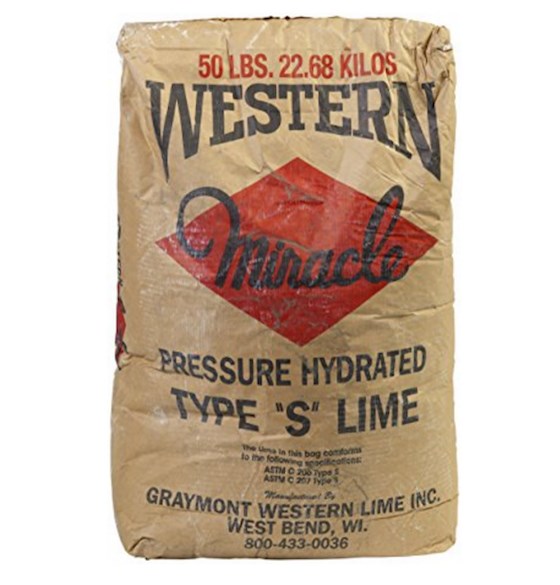Sand and Brick Mortar

Sand and Brick Mortar | This brick was installed 129 years ago. This might very well be the original mortar. It’s survived many a harsh New Hampshire winter. Copyright 2020 Tim Carter
Sand and Brick Mortar - Big Differences
DEAR TIM: I need to repair the mortar joints on my older brick home that was built in the late 1800s. I’ve seen some very horrible workmanship where the mortar doesn’t match at all and want to avoid this. Is there some sort of magic one employs to do tuck-pointing that matches the original mortar? I know this is impossible, but if you were to come to my house to help me, what would you do to make sure the finished repair was nearly invisible? Is this even a realistic goal, or should I just resign myself that there will be these ugly mortar joints that don’t match? Rhonda S., Boston, MA
Many years ago, I witnessed what Rhonda saw. Some mason, handyman, or DIYr attempted to tuck-point the mortar joints on a brick home and the resulting mess was almost hurtful to the eyes. Not only was the mortar smeared on the brick, but it was also such a light color that the difference between the old and new was like night and day. It reminded me of a person with a smear of food on their face while eating. You have a tough time looking at her/him from across the table, to say the least.
Related Links:
More Secret Tips on Matching Mortar
Matching Brick Color and Texture
Who Knows the Truth About Mortar?
I feel Rhonda’s question provides an excellent teaching moment. You may be a person that rushes to the Internet hoping to locate a video or someone who passes himself off as an expert about masonry and mortar. I propose that you engage your critical-thinking skills and step back for just a moment before you follow that advice. Think about WHO is the real voice of authority in the field.
When I first started building back in the 1970s I used to go to the library to learn about building. The library housed one of the search engines of our time - the library card catalog. One day, I was researching for concrete installation information and I stumbled across some pamphlets at the library published by the Portland Cement Association.
CLICK or TAP HERE to get FREE QUOTES from local bricklayers who can match mortar.
I had never heard about associations before, keep in mind I was a mere 23 years old and had very little life experience. Before long, I discovered there were scads of associations that represented building products. These associations are in the business of not only promoting their products but more importantly how to install and take care of them the best way.
In short order, I discovered the Brick Industry Association (BIA) and once there was taken aback by their vast library of Technical Notes about everything you could ever imagine about brick, mortar, flashings, chimneys, etc. I reached out to them at the time and they mailed to me at no cost two massive binders filled with all of the Technical Notes publications. I thought I had died and gone to Heaven.
You and Rhonda would do quite well to read two of the Technical Notes publications: Numbers 8 and 8B. Both deal with mortar and now you can get them as free PDF files from the BIA website: https://gobrick.com
Hydrated Lime Has a Rich History
Here’s what you’ll discover. There are different types of mortar and mortar used a hundred years ago is not necessarily like the mortar mix you’d buy today at a building supply business. Many years ago, it was common for bricklayers to just use hydrated lime and sand to make their mortar. Hydrated lime is truly a magical building material.

This is an excellent hydrated lime. It's a fine white powder and it's going to look great on your home. CLICK or TAP HERE THE IMAGE TO ORDER SOME RIGHT NOW. You may see a different type of bag, but if it says "Hydrated Lime", it's the right stuff!
Modern mortars come in all types depending on the finished design strength of the masonry. It can get very complicated very fast. Suffice it to say that many modern mortar mixes are a proprietary blend of Portland cement, hydrated lime, and other ingredients blended for the design purpose of the mortar.
What Creates Color in Mortar?
One of the places that masons, handymen, and DIYers go off the rails is the sand component of the mortar. Look closely at an older weathered mortar joint in between two brick and you’ll quickly notice that you see more sand than you see the actual cementitious powder that binds the sand together! This is very important when you are trying to match the color and look of the mortar.
You need to do some homework and locate the same sand as what you have in your existing mortar if you want to get a close color match once the mortar is installed. Think back where the bricklayers of old would have obtained the sand. It was hard back 100 years ago to transport heavy things great distances. Is there a nearby gravel pit that’s still in operation? Do old newspaper clippings talk about local gravel pits that are now closed? Do what you have to do to locate sand that’s the same size and color range as your existing mortar.
Tim Carter Can Come to Your Home
It’s not out of the realm of possibilities to have me show up at your house. I do that sort of consulting work. CLICK or TAP HERE to have me show up at your home for an 8-hour consult. I have helped homeowners before. Here’s the first thing you and I would do to start the project.
What Are the Steps to Match Mortar Color and Texture?
I’d clean the existing masonry. There’s a good chance the existing house is dirty and so the mortar would be dirty too. I’d want to clean the mortar, at least on the wall that’s being repaired, so I could see exactly what we must match. You can use a pressure washer for this job, but you need to exercise extreme caution that you don’t damage the brick or the mortar.
Once the brick and mortar are clean and dry, we need to judge to see if we feel the brick masons colored the mortar. It was often done on jobs so the mortar had a tint close to the color of the brick. I’d then mix up a test batch of the mortar using the guidelines from the BIA technical notes #8 and allow it to dry for a week or two. You and I would then use a very very mild acid wash to dissolve the lime from the sand on the surface to see if we have a match. We need to expose the actual sand particles to see the true finished color of the mortar.
Column 1363